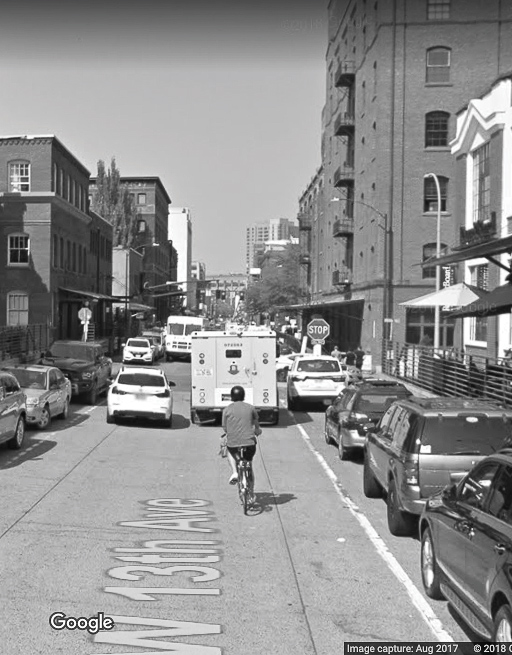5.3. Industrial Area
Aus Pattern Language Wiki
Within the Polycentric Region, there are many places where industrial activities must be accommodated. These should be integrated into the walkable street...
Problem-statement: Industrial employees increasingly want to work in vibrant, mixed neighborhoods. But industries need a certain amount of security and privacy for their operations.
Discussion:: Well-meaning planners reacted to pollution within early industrial cities by relocating all industry outside the city. But that move threw out the baby with the bathwater: it forced employees to commute long distances, and created isolated, lifeless districts. Today, only genuinely heavy industry needs to be accommodated outside. Most other light industrial activities fit well within a mixed-use city (with air and water quality protected by enlightened regulation). This mixing of work and life is the way that cities have thrived for millennia. Mixed use also facilitates commuting to work, and is one of the cornerstones of a new conception of the city as a complex system: the functions cannot be simplistically segregated without damaging it.
A new rationale for segregation in the 20th century has been security, especially security of trade secrets. This has given rise to the “supercampus” — a very large, gated, and impenetrable section of the urban (or more often suburban) fabric. This has been a terrible mistake, creating dead zones at the edges of these supercampuses, and almost always preventing employees from walking, biking or even taking transit to or from work — more likely forcing them to drive, and therefore to own a car. Even worse, this supercampus model further isolated work from home and other activities, causing an imbalance between jobs and housing, requiring extensive commuting time, and contributing to a fragmented, resource-inefficient, dysfunctional city.
In the early years of the 21st Century, the most sought-after employees have begun to demand more walkable, mixed places of work, closer to their homes and other destinations, and the supercampus is rapidly losing its competitive edge. More companies have begun to integrate their buildings into the urban fabric of walkable “innovation districts” and other creative neighborhoods.¹
Evidence has grown that there are significant economic benefits for the companies as well. Creative innovation does not thrive in isolated, inward-turning campuses, but in places that allow mixing and “knowledge spillovers” — not only within industries, but between them as well, and within the public spaces surrounding them.
Therefore:
Do not build isolated “supercampuses” as industrial workplaces. Instead, create a flexible cluster of buildings within a walkable street system, mixed with other uses so that employees can live nearby, and visit other destinations.
Provide a Walkable Streetscape within the industrial area, with a mix of other uses to provide amenities and close-by housing for some employees…
¹ Notable research on this trend and its dynamics has been done by the Brookings Institution. See for example Katz, B., & Wagner, J. (2014). The rise of innovation districts: A new geography of innovation in America. Washington: Brookings Institution.
Mehaffy, M. et al. (2020). INDUSTRIAL AREA (pattern). In A New Pattern Language for Growing Regions. The Dalles: Sustasis Press. Available at https://pattern-language.wiki/.../Industrial_Area
SECTION I:
PATTERNS OF SCALE
1. REGIONAL PATTERNS
Define the large-scale spatial organization…
1.4. 400M THROUGH STREET NETWORK
2. URBAN PATTERNS
Establish essential urban characteristics…
3. STREET PATTERNS
Identify and allocate street types…
4. NEIGHBORHOOD PATTERNS
Define neighborhood-scale elements…
5. SPECIAL USE PATTERNS
Integrate unique urban elements with care…
6. PUBLIC SPACE PATTERNS
Establish the character of the crucial public realm…
7. BLOCK AND PLOT PATTERNS
Lay out the detailed structure of property lines…
8. STREETSCAPE PATTERNS
Configure the street as a welcoming place…
9. BUILDING PATTERNS
Lay out appropriate urban buildings…
10. BUILDING EDGE PATTERNS
Create interior and exterior connectivity…
10.1. INDOOR-OUTDOOR AMBIGUITY
SECTION II:
PATTERNS OF MULTIPLE SCALE
11. GEOMETRIC PATTERNS
Build in coherent geometries at all scales…
11.2. SMALL GROUPS OF ELEMENTS
12. AFFORDANCE PATTERNS
Build in user capacity to shape the environment…
13. RETROFIT PATTERNS
Revitalize and improve existing urban assets …
14. INFORMAL GROWTH PATTERNS
Accommodate “bottom-up” urban growth…
15. CONSTRUCTION PATTERNS
Use the building process to enrich the result…
SECTION III:
PATTERNS OF PROCESS
16. IMPLEMENTATION TOOL PATTERNS
Use tools to achieve successful results…
16.2. ENTITLEMENT STREAMLINING
16.3. NEIGHBORHOOD PLANNING CENTER
17. PROJECT ECONOMICS PATTERNS
Create flows of money that support urban quality…
17.4. ECONOMIES OF PLACE AND DIFFERENTIATION
18. PLACE GOVERNANCE PATTERNS
Processes for making and managing places…
18.3. PUBLIC-PRIVATE PLACE MANAGEMENT
19. AFFORDABILITY PATTERNS
Build in affordability for all incomes…
19.1. INTEGRATED AFFORDABILITY
20. NEW TECHNOLOGY PATTERNS
Integrate new systems without damaging old ones…
20.2. RESPONSIVE TRANSPORTATION NETWORK COMPANY


